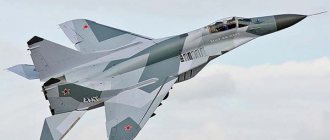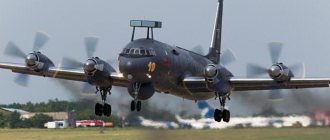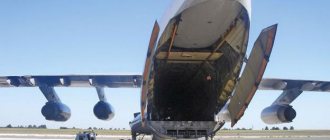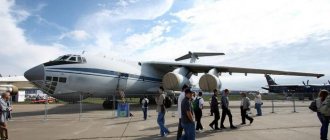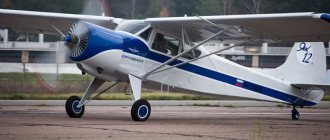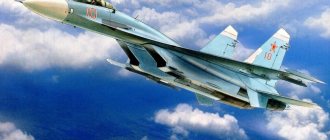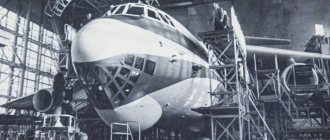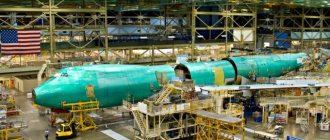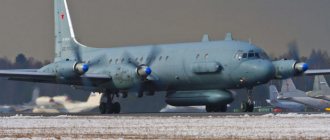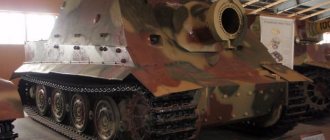The capabilities of the USSR defense industry were repeatedly underestimated by opponents, both potential and very real. A number of samples of Soviet weapons in the history of the country have become a standard for designers of the most industrially developed states. Some of them even became unique symbols of the armed forces of the USSR and the new Russia. The fame of Shpagin and Kalashnikov assault rifles, T-34 and T-54 tanks, Katyushas and other types of Russian lethal products has gone far beyond the borders of a sixth of the landmass. MiG combat aircraft are also among the domestic weapons classics.
History of the MiG Design Bureau
The design bureau began working before the Great Patriotic War. By 1940, engineers A.I. Mikoyan (brother of Stalin’s People’s Commissar) and M.I. Gurevich managed to create a magnificent fighter aircraft, one of the best in the world in terms of its characteristics. It had a number of shortcomings, but at the time of the first test takeoff, this light, high-speed machine with streamlined lines could compete with any aircraft in Germany, Britain or the United States.
The design bureau has always strived not only to follow global trends in aircraft manufacturing, but also, whenever possible, to set them. The first production jet fighter in the USSR, the MiG-9, was a response to the successful introduction of aircraft of this class into the Western Air Forces.
Jet Age
An unpleasant surprise for American pilots was the MiG-15, which in terms of speed and maneuverability characteristics was superior to the vaunted products of Northrop and other US manufacturers, who considered their equipment unsurpassed. In the skies of warring Vietnam, the MiG-17 and MiG-21 interceptors performed excellently. There were other aircraft models, MiG-19 and MiG-23. During Israel's war with Egypt, the super-powerful MiG-25 repeatedly violated the front line, conducting raids over Tel Aviv. And although it did not carry any weapons, the very fact of the unpunished flight of a Soviet plane over a country armed with the latest American air defense systems cooled many hotheads. A number of regional conflicts, in which Soviet MiG military aircraft showed their best side, became a kind of advertisement for this brand, a guarantee of the quality and highest efficiency of Soviet military equipment. The crowning achievement of the designers' efforts was the MiG-29. Even today, 37 years after the completion of the main design work, the technical characteristics of this fighter fully meet the modern requirements for combat vehicles of this class.
Mass production
The weak technical characteristics of the MiG-29 were the reason for the delay in its launch into mass production until 1982.
In general, this delay is due to the crash of two planes. The first mass-produced fighters appeared at the Kubinka base a year later. A year later, the cars underwent mass testing for the first time. Then the instructor regiment of the Combat Use Center also received its fighters. The first fighter regiment, which also received MIGI, was stationed in Ivano-Frankivsk. Thanks to the highly qualified pilots, all these air regiments quickly achieved operational readiness.
When the first aircraft were delivered, the leadership of the air regiments divided the tasks between light and heavy aircraft and machines. The heavy model had an increased range, so it could search for air and ground targets at fairly large distances. The duties of a heavy fighter pilot included the detection and destruction of NATO aircraft.
MiG-29M/OVT - all-angle
Important government assignment
In the late sixties and early seventies, the main “workhorse” of the US Air Force and several countries - potential opponents of the USSR - was the famous F-4, “Phantom” of various modifications from McDonnell-Douglas. The design of this aircraft was very successful; it could solve tasks that were universal in nature - from conducting maneuverable air combat to launching bomb and missile strikes on ground targets. But the experience of Vietnam and the Middle East showed that it was difficult for him to fight against the Soviet MiG-21 and even the earlier MiG-17. The loss ratio was not in favor of the Americans. In the United States, work began on creating a replacement for the Phantom, which resulted in the F-14 Tomcat and F-15 Eagle fighters. The Soviet Air Force urgently needed modernization, taking into account promising projects of overseas aircraft manufacturers with their “cats” and “eagles”. The Soviet government set a task for the MiG design bureau. By the fall of 1977, the newest MiG-29 interceptor was ready. The prototype took off on October 6. Five years later, the aircraft was adopted by the USSR Air Force.
The main tasks of promising fighters
Considering that the flight altitude of the MiG-29 is 18,000 meters, then not any missile can reach it. The developers of this model designed a fighter with the following capabilities:
- Armament: missiles and cannons.
- Escorting heavy bombers to protect against enemy fighters.
- Flights for reconnaissance purposes.
- Interception of air targets.
- Reliable counteraction to enemy aerial reconnaissance assets.
- Air cover for ground forces.
- Detection of ground targets.
- Eliminate enemy aircraft using guns and missiles.
- The maximum flight altitude is 18 kilometers. Due to this , this model cannot be hit with any weapon.
A little about appearance
In those years, even the appearance of a new type of weapon was a state secret. Indeed, many revolutionary technical solutions, including conceptual ones, became a distinctive feature of the MiG-29 interceptor. A photo carelessly published in the press, or a recording of a demonstration flight shown on television, could lead specialists from the hostile camp to think about the main line of aircraft manufacturing of the future. According to the idea of the Chief Designer M. Waldenberg, supported by R. Belyakov, who replaced Artem Mikoyan as General, the aircraft had a so-called integrated circuit layout. This means that the design bureau has moved away from the division of the structure into planes and fuselage, which is customary in world aviation. The entire airframe consisted of smooth transitions, swells, with “classic” side walls only in the bow.
The secrecy measures were by no means an unnecessary precaution. The specialists who designed MiG aircraft were also able to spy on other people’s new products. A photo of the adjustable air intake of the mentioned Phantom, taken at one of the air shows, at one time gave invaluable information to our engineers. A similar unit was used on the MiG-23.
Design developments and experiments
The peak of design and testing of the new fighter fell in 1974-1977. 19 new prototypes were allowed to be tested, including a two-seater. The first prototype under the name “9-01” was taken into the air by test pilot A.V. Fedotov in October '77. Models “9-02” and “9-04” were intended to test the characteristics and capabilities of the new fighter’s engines. Unfortunately, both prototypes crashed, but the pilots managed to eject in time and survive.
The aircraft, under the working name "9-03", became the prototype of the MiG-29 fighter. The remaining prototype models were used to test and improve the aircraft's onboard systems. During testing, a defect was found to be insufficient stability of the aircraft. This problem was solved by installing ventral fins, and then on production models, starting with the fourth, this problem was eliminated by increasing the rudders, and the fins were no longer used. The design bureau planned a full and comprehensive test of all 19 prototypes, during which time these aircraft made about 2 thousand sorties.
Full-scale production of the MiG-29 fighter aircraft began in 1982 at one of the oldest aircraft factories in our country, namely, which is located in the capital of our country. The final assembly of the aircraft took place in Lukhovitsy, and a fly-by of the manufactured aircraft was also carried out there.
This fighter model was discontinued from mass production in 1990; during these 8 years of production, more than a thousand combat vehicles were produced, and 300 units were exported to other countries. The number of 29 MiGs could have been significantly larger, but in the 90s, the advantage was given to what the designers believed was the best fighter aircraft, the Su-27. Despite this, in the 90s and early 2000s the production of MiGs continued, but in small quantities. Over the entire period, 1.5 thousand MiG-29s were designed and launched into the sky.
Power plant and bell figure
The aircraft has two engines (RD-ZZ or RD-ZZK for modification “M”), they are located below the wing. Their total thrust can reach from 16,600 to 17,600 kN (kgf). If we take into account that the take-off weight of the machine slightly exceeds 15 tons, then it is easy to conclude that the value exceeds the thrust-to-weight ratio of the unit. This in turn means that if the MiG-29 aircraft is installed vertically and the throttle sectors are brought to a position close to the limit, then it will hover in place or rise higher without the participation of the wing lift. This technical feature allows not only to demonstrate unique aerobatic maneuvers at demonstration performances, but also has important practical significance. The locators operate on the Doppler principle and can only track moving objects. At the moment of performing the “bell” and “cobra” (that’s what aerobatics are called, during which a “hover” occurs), the speed of the MiG-29 aircraft is zero, and all control and guidance systems of enemy air defense systems cease to see it on their screens .
Fighter design
The MiG-29 is a fourth-generation multi-role front-line supersonic fighter. Made according to a normal aerodynamic design, a mid-wing with a trapezoidal mechanized wing. It has a two-fin vertical tail with all-moving stabilizers. The plane has a so-called integral layout: the fuselage and wing form a single supporting body, which provides less drag and greater lift at high angles of attack.
Two RD-33 engines are located in engine nacelles in the rear fuselage. The RD-33 gas turbine engine is a two-shaft, dual-circuit engine with an annular combustion chamber, an adjustable nozzle and a hydroelectronic control system.
When taxiing on the ground, the ventral air intakes are closed with special curtains that prevent debris from entering the engines.
"Gills" MiG-29
There are other solutions in the aircraft design that demonstrate a fresh approach to solving pressing problems. A powerful power plant requires a lot of air, and it is sucked into the intake intake in huge quantities. If the runway is snowy, has sand on it (which is not uncommon in some regions) or other contaminants, all this gets inside the turbine. There are several ways to deal with this scourge. For example, you can install air filters like in a car. But they also tend to get clogged. Or another solution: place the air intakes higher. But this worsens the aerodynamic properties of the aircraft's airframe. In the case of the MiG-29, the designers made an unusual and unique decision. Air intake until the landing gear is retracted is carried out through additional inlet openings on the upper fairing connecting the wing to the fuselage. There are two rows of them, they are located symmetrically on the right and left sides. They were called "gills". During takeoff and landing, the main air intakes are completely closed, and only after reaching a height sufficient for safe operation are they opened.
Avionics
The MiG-29 aircraft is famous not only for its powerful engines and excellent aerodynamics. Technical characteristics, no matter how excellent they are, do not guarantee victory in modern air combat if the pilot is not provided with ergonomic conditions and information support that provide the ability to make instant decisions. Still, the fourth generation obliges us to do something, especially since our potential opponents have always treated the latest advances in electronics with great attention. The fact that the information and computing complex is based on an on-board computer (this is Ts100.02-06) is not surprising. For the first time in the country (and perhaps in the world), many additional devices have been used to make the pilot’s work easier. In particular, “Natasha” (as the pilots nicknamed the voice indication system; in fact, it is “Almaz-UP”), in a pleasant female voice, will inform you that the landing approach is being carried out at insufficient altitude or speed, will notify about the enemy entering the tail, or other danger, error or emergency.
Controlling the weapon is very convenient. The information is projected onto the front glazing of the cockpit canopy, and a target designation system is installed on the headset. I looked at the plane, decided to attack, pressed the combat cocking button - and we can assume that the enemy is no longer there. Our pilots have such a deadly look. And if you are confused and have lost your spatial orientation, then it’s okay, you press another button, and the plane itself will level itself both in trim and in roll.
Electronic control system
In a modern military aircraft, separating avionics and weapons control systems is very difficult. Without a radar sensitive to target detection against the background of the earth's surface, it is almost impossible to win today, but this device also performs a navigation function. The MiG-29 aircraft is equipped with a NO-93 type radar, capable of tracking a dozen targets simultaneously. It is an integral part of the OEPRNA-29 targeting and navigation system, which can perform operational mapping and calculate algorithms for attacks on enemy sea and ground targets. It also includes an OEPS-29 optical-electronic sighting system; the latest achievements of quantum physics were used in its development. The target is detected and identified at a distance of 35 km (when catching up) to 75 km (in free space). In general, the control system is complex, but despite this, it is convenient to use.
What to shoot with?
The experience of the Vietnam War showed that it is difficult to conduct an air battle, especially a maneuverable one, with missiles alone. Having deprived the Phantom of artillery, the Americans were forced to invent special hanging containers with a cannon and ammunition. The MiG-29 fighter is armed with a rapid-fire (1,500 rounds per minute) water-cooled GSh-301 cannon, which has a supply of one hundred shells (30 mm caliber).
For missiles, there are six external pylons mounted under the wings. Depending on the tasks being solved, they can be equipped with missile launchers (R-73 or R-60M). To strike ground targets, missile launchers of the X-25M type are used. The guidance of these means is carried out either by a television signal or by a laser beam. Aiming of unguided weapons (unmanned aerial vehicles in cassettes, bombs) is carried out using radar. Naval targets are hit by the Kh-29 guided missile or supersonic anti-ship missiles of the Kh-31A type, which the MiG-29 can carry. Armament with advanced missile models is incorporated into the design of the suspension units.
The total number of bombs and missiles is limited to a maximum combat load of 3 tons (base model) and 4.5 tons (MiG-29M).
Current situation
As you know, the MiG-29 cockpit is designed for two pilots, however, the machines are still outdated morally and physically, since they have exhausted their service life. The exception is 30 new MiG-29SMT models. Outdated aircraft are still maintained in working order, thanks to ongoing repairs. Their major repairs are considered impractical. Despite the fact that the performance characteristics of the MiG-29 are unique, it was decided to replace the outdated models with the MiG-35 fighters. The machines of these models are designed for one and two pilots.
MiG-33 (or MiG-29M) - further development of the MiG-29
TTX Mig-29
The aircraft is somewhat smaller in size and weight than its contemporary American counterparts, which include the F-14 and F-15. The wingspan of the Soviet interceptor is slightly more than 11 meters (the same for the Tomcat at maximum sweep, and for the Igla - 13 m). The length is 17 meters including the in-flight refueling rod (versus 19 for each of the “Americans”). The MiG-29, which weighs about 15 tons, is lighter than both aircraft - likely opponents (about eighteen tons each). The thrust of the two turbines exceeds that of American cars and reaches 17,600 kN (14,500 for the Tomcat and just over 13 thousand for the Eagle).
The relatively small wing area (38 sq. m.) can be alarming due to the high specific load, but it is compensated by the high strength of the airframe due to the features of the integral layout. The speed of the MiG-29 reaches 2.3 M (2,450 km/h); for the deck version of the MiG-29K it is slightly lower, 2,300 km/h. For comparison: the F-14 is able to develop 1.88 M (1,995 km/h), and the F-15 – 2,650 km/h. Another important indicator is the length of the run during takeoff and landing. For a MiG to take off, it only needs a runway 700 meters long, and in afterburner mode - only 260 meters. It lands on a platform 600 meters long. This allows it to be used as a carrier-based aircraft (with a cable braking system) or operated in poorly prepared airfields (or even highway sections, as happened during the Yugoslav War). Both American cars have approximately the same running characteristics. The possibility of using the fighter as a base aircraft on aircraft-carrying ships is also provided structurally; the wing consoles are foldable. The landing speed of the MiG-29 is 235 km/h, which also indicates its “sea soul”. American deck ships have the same indicator.
The MiG's service ceiling reaches 17 thousand meters and occupies an intermediate position between the F-14 and F-15.
The average combat qualities of the Soviet MiG-29, technical characteristics and its maneuverability suggest that this aircraft is superior to all foreign analogues developed at the same time as it. The ability to disappear from radar screens in the midst of air combat makes this vehicle unique. Innovations applied in the control system have brought the domestic aviation industry to a qualitatively new level. It is also important that the MiG-29 fighter has a wide modification potential. More than two dozen of its varieties with different target orientations, different flight ranges, with on-board electronic equipment differing in functionality, from a front-line fighter to a training “flying desk”, have been produced. Two of them (MiG-33 and MiG-35) are separated into independent models of the design bureau line named after. Mikoyan and Gurevich.
Flight performance
- The length of the aircraft is 17.32 m.
- Height - 4.73 m.
- Wing span - 11.36 m.
- Maximum speed is 2450 km/h (Mach 2.3).
- The thrust of one engine in the “full afterburner” mode is 8300 kilograms-force.
- Practical ceiling - 18 thousand m.
- Practical flight range at high altitude is 1 thousand 430 km (with external fuel tanks - 2 thousand 100 km).
- Maximum take-off weight is 18.1 tons.
- The maximum combat load weight is 2.18 tons.
- Crew - one person (in the combat training modification - two).
With different emblems on the wings
After the collapse of the USSR, the military aircraft fleet of a single state was divided between the former Soviet republics. Experiencing financial difficulties, many of them began to sell equipment they did not need. For example, Moldova lost two dozen used MiG-29s to the United States. The cost of each aircraft was $2 million, which is many times lower than the market price. The Americans needed this interceptor to practice tactics in combating the air forces of the countries in which it is in service. MiGs were sold to conflict zones in Africa, Asia and other parts of the world.
The air forces of the Warsaw Pact countries were also armed with MiG-29s. Almost all of them came to the disposal of Russia’s “partner” in the person of NATO. The pilots of the German Luftwaffe, accustomed mainly to American technology, were pleasantly surprised by the ease and ergonomics of control - characteristic qualities of the MiG-29. Photos of the Soviet fighter with Maltese crosses (identification marks of the German Air Force) at first caused bewilderment among the uninitiated, then everyone got used to it.
The aircraft is in service with more than twenty-five countries, and they have no plans to change it for anything yet.
When choosing a defense supplier, foreign governments are guided primarily by military merit and political considerations. But the financial aspect of the transaction is also important. The MiG-29, which costs approximately 70-75 million dollars per unit, can solve most specific military tasks no worse than its overseas competitor F-15, for which they “ask” up to hundreds of millions. In our time of crisis, such a difference clearly plays into the hands of the Russian Oboronexport.
The truth about the MiG-29 (23 photos)
Author: Mood Stabilizer
27 August 2014 15:42
Tags: USSR Air Force interesting history MIG-29 weapons confrontation cold war
17940
23
How American intelligence agencies solved the mystery of a Cold War killer. I’ll say right away that there are a lot of letters in the article, but the material is very interesting.
0
See all photos in the gallery
A hornet's nest has grown in the nose of a MiG-29 (Fulcrum by NATO classification) parked near the National Air and Space Intelligence Center at Wright-Paterson Air Force Base in Ohio. The tires on its wheels, raised above the ground by its racks, were cracked and torn. Bird droppings have dried on the fairing. The plane gives the impression of a war trophy, displayed like a head on a pike. In a sense, this is a trophy taken as a result of victory in the Cold War. It is one of seventeen MiG-29s purchased by the US government from the former Soviet republic of Moldova in 1997.
0
They purchased the planes so that they would not be sold to Iran. The weak confederation that replaced the Soviet Union had no power to stop the deal, another act of humiliation after the collapse of the USSR. “Any military department in any country would be seriously upset if the enemy were given the opportunity to study and test its most modern weapons,” says Moscow aviation historian Sergei Isaev. “I wonder if the White House and the Pentagon would be happy if, for example, Mexico tried to sell its UH-60L Blackhawk helicopters to the Russian Federation?”
×
0
The acquisition also gave Western analysts, some of whom worked in the gloomy building of the nation's intelligence center, a chance to study the fighter they had been eyeing from afar for 20 years. When the MiG-29 first appeared in 1977, it, like its distant ancestor the MiG-15, was a stunning revelation: it turns out that the Soviets were catching up with the United States in the field of aviation technology!
0
American intelligence first learned of the new Soviet aircraft from satellite photographs taken in November 1977, around the same time the fighter made its first flight. “You only had to look at its size and shape to understand that the Soviets were designing the equivalent of our F-16 and F/A-18,” says Benjamin Lambeth, who wrote the 1999 book Russia's Air Power in Crisis. crisis period), and in the late 1970s worked as a military analyst at the RAND strategic research center in Santa Monica, California. “From all the numerous intelligence sources and means of collecting electronic and other information, the American government knew quite a lot about this aircraft from the very beginning, and it was clear to us that something had to be done.” The Air Force began designing stealth technologies and electronic systems to track and target multiple aircraft at once. In 1981, the Air Force made the first official application for the development of the next generation of fighter equipment - a promising tactical fighter, which eventually appeared and was called the F-22 Raptor.
0
In subsequent years, the scattered information that was collected about the MiG-29 developed into a more understandable picture, because it became possible to study 21 Moldovan MiGs. From 20 to 27 October 1997, these MiGs (14 front-line fighters of the "C" model, six older "A" models and one two-seat "B" modification aircraft) were dismantled in Moldova and sent in parts to the national intelligence center in Dayton, where they were carefully studied at the facility for the operation of foreign military equipment. What happened next is not reported by the National Air and Space Intelligence Center. The center's public affairs officer, James Lunsford, says, "We don't want our adversaries to know what we know." Perhaps a few MiGs that were in airworthy condition were sent to Edwards Air Force Base in California for testing. At least one example ended up in Nevada at Nellis Air Force Base. There he was sent to a training center, which the pilots call “a menagerie for young animals.” In the center there is a whole exhibition of foreign-made military equipment, which is displayed there for young intelligence officers to familiarize themselves with it. As for the remaining vehicles and parts, the data on them is classified, with the exception of the first model “A”, which ended up in the National Museum of the US Air Force.
0
Inside the museum, curator Jeff Dufford invites me to explore the Cold War gallery, spread across nearly four thousand square meters of exhibition space. First, he shows me the Checkpoint Charlie exhibit. This newly acquired NASA space shuttle crew bay simulator takes up the entire left side of the hangar, pushing the planes to the right, where they stand like a hodgepodge. There, the second MiG-29 from Ohio stands nose to nose with an unattractive Fairchild Republic A-10 attack aircraft, nicknamed Warthog. Dufford removes the fencing tape and we move closer to take a closer look at the plane. Unlike the Mig-29 rotting near the reconnaissance center, this example is remarkably restored and luxuriates in climate-controlled comfort, enjoying the soft glow of the lamps and gleaming with fresh paint that feels like satin.
0
Let's face it: Soviet fighters were ugly, and the MiGs are easily the nastiest looking ones. The MiG-17 and MiG-19 aircraft from the Vietnam War are a utilitarian tube with wings. Following them came the deadly MiG-21s, a rational sculpture of angles and a cone. But the Mig-29 is completely different. This beautifully streamlined machine resembles its twin-finned, flat-sided contemporary, the F-15 Eagle, no more than a ballerina from the Bolshoi Theater resembles a boxer from a street ring. When the gallery is ready, these two icons of air combat will be displayed together, Dufford says. Or the Fulcrum will show off alongside its sleeker rival, the F-16. Dufford and his colleagues are coming up with a plan to display the exhibits so that the MiG-29 looks like the worthy adversary that it is.
0
“We're very lucky to have this aircraft,” says Dufford, running his hand over the MiG-29's right air intake. — When he arrived to us, he had Moldavian Air Force paint on him. Everything was done very roughly. When repair work began, workers scraped the surface in hopes of finding tail numbers (the Air Force equivalent of a serial number). During the cleanup, the number 08 clearly appeared.” Having learned the number, Dufford realized that this MiG was not only one of the first combat vehicles of this brand, located at the Air Force base in Kubinka, near Moscow, but also one of the first aircraft shown outside the Soviet Union. “Some details helped to clarify its origin,” says Dufford, “Plates to reflect the flame .... There are only six holes, and this suggests that our plane is one of the first models.” Another clue was the way the numbers were applied. Unlike US Air Force aircraft, where the size rules are very strict, down to the millimeter, “on Russian aircraft, the distance between the numbers can be different,” Dufford notes. He carefully studied photographs of the MiG-29 taken in 1986 at an aviation exhibition in Finland in Kuopio-Rissala. “It's like fingerprints. Looking at the distance between the numbers and their location, I was convinced that this car was exhibited in Finland.”
0
In 1986, Jukka Hoffren was a photographer in the Finnish Air Force, working at Tikkakoski Air Base, where the Finnish Air Force Academy is located. Fascinated by the new MiG, Hoffren went to the airshow in Kuopio-Rissala, where the international debut of this aircraft was to take place. Until 1986, foreigners only saw the fighter in fuzzy satellite images published in Aviation Week & Space Technology magazine. “This whole airshow was built around the MiG-29,” Hoffren told me via email. The Soviets were interested in selling their new aircraft to the Finnish Air Force, which had a very diverse fleet of aircraft due to the complex politics of post-war Finland, regulated by various treaties. The air force included the Soviet MiG-21 bis, the Swedish Saab Draken, and the British Hawk produced by British Aerospace. According to Hoffren, compared to the highly capable MiG-21, which was built in Tbilisi, Georgia in a construction method that could be called “hammer finishing,” the new MiG was a stunning machine. “If the MiG-21 can be called a missile with wings, then the MiG-29 was a very maneuverable aircraft in air combat, and it seemed that it was in no way inferior, and maybe even superior, to the F-16.”
0
Seeing not a photograph, but a real car, which Hoffren did in Finland, was much more educational; but an airplane can only be truly known in flight. And in December 1989, Lambeth received such an opportunity. On December 15, at the base in Kubinka, in disgusting weather conditions, he became the first Western analyst to fly on the MiG-29, and also the first Western representative since the end of World War II to be invited to fly in Soviet airspace in a combat aircraft. (A Canadian fighter pilot flew the MiG in August 1989 at the Abbotsford Airshow.) Two years after the Mig-29's debut at Kuopio-Rissala, the Soviets showed the machine in England at the Farnborough Air Show and in 1989 at the Paris Air Show. At the time, Lambeth was a senior research analyst at RAND. He previously worked as a specialist on Soviet military equipment for the CIA, as well as a civilian pilot. Lambeth's work at RAND, specializing in tactical air combat applications, gave him the opportunity to fly many jet aircraft with excellent tactical performance. In Farnborough, he met the chief test pilot of the Mikoyan Design Bureau, Valery Menitsky, who accompanied a group of pilots, technicians and maintenance personnel at the first major Western exhibition where the MiG-29 participated. They became friends.
0
“I've been writing about Soviet aircraft for many years,” says Lambeth. “When I heard that the MiG-29 would be brought to Farnborough, I couldn’t believe it. I couldn’t even imagine that I would be so lucky and be able to fly on it. It was a kind of Cold War drama - a man who worked for the CIA gets the chance to take to the skies in a Soviet fighter with a red star.” Lambeth told Menitsky that he really wanted to fly the MiG-29. “He didn’t fall out of his chair laughing, but said maybe it would work.” Lambeth's timing was right: Soviet leader Mikhail Gorbachev had recently begun a policy of glasnost, and since the Soviets were hoping to sell the new fighter to other countries, they were willing to demonstrate its capabilities and performance in every possible way.
0
The weather in Kubinka that winter was disgusting, so before taking off on the MiG-29UB, Menitsky took the front seat, and Lambeth climbed into the back. The flight included a series of maneuvers that Lambeth had performed several weeks earlier in an Air National Guard F-15 at Hickam Air Force Base in Honolulu. Lambeth's report to RAND, published in 1990, was the first unclassified analysis of the previously mysterious fighter. Lambeth stressed that he had not received any training as a test pilot or fighter pilot, but in his report he described in detail his impressions of flying in the MiG-29 cockpit. Soon the West learned everything about the MiG-29, gaining the opportunity to operate it. Three months before Lambeth's Kubinka flight, some 7,000 East Germans had crossed into Hungary on tourist visas and set up camp near Budapest. On September 10, 1989, Hungary officially opened its border with Austria, allowing refugees to travel to West Germany. By 1990, Germany was unified, and the day after Christmas 1991, the Soviet Union ceased to exist.
0
The MiG-29 was the only combat aircraft in the East German armed forces that the unified German government retained as part of the air force. "The Germans provided an invaluable service," says Rob Young, an Air and Space Intelligence Center historian. “They told us more about the MiG-29 than we could have learned anywhere else.” We had majors and lieutenant colonels as part of the exchange program. It was similar to the MiG-15 in that we were creating models and conducting simulation experiments with it long before we were able to get this machine.” During the Korean War, the Air Technical Intelligence Center, the precursor to the National Air and Space Intelligence Center at Wright-Paterson AFB, obtained parts from a crashed MiG-15 and examined the wreckage to learn more about the performance of the game-changing MiG. US Air Force test pilots were able to fly the aircraft after a North Korean pilot defected in September 1953.
0
In 1991, former East Germany had 29 MiG-29s based at Preschen near the Polish border. As the Iron Curtain fell, West German pilots and technicians began assessing their former adversaries to see if they could be integrated into the new German Air Force. They eventually began a training program in which former East German pilots served as instructors. The best of the best young West German lieutenants and captains were selected for retraining on the MiGs. In subsequent years, the 73rd Fighter Wing, which was relocated to Laage on the Baltic coast, was bombarded with requests from Western air forces and navies wanting to fly in mock combat against the MiG-29.
0
Peter Steiniger was a West German Air Force fighter pilot and graduate of the prestigious European-NATO Joint Jet Pilot Training Course at Sheppard Air Force Base, Texas. Returning to Germany, he flew the F-4F, which was the export version of the legendary McDonnell Douglas Phantoms, which were in service with the German Air Force until 2013. When he was a lieutenant in 1986, he and his comrades were shown satellite images of a sobering new Soviet development. But less than five years after unification, he found himself in a surreal circumstance born of the convoluted twists of history: Steiniger not only became a highly trained MiG-29 pilot, but also the 73rd Wing operations officer coordinating the exchange program. “For example,” says Steiniger, “I pair a young, anxious, overexcited F-16 pilot with an ex-GDR Air Force pilot. They rise into the sky and perform several basic maneuvers common in fighter aircraft. We had hundreds of such sorties, and thousands of lessons during debriefings with colleagues from Western aircraft who listened to us and watched our videos...mostly in amazement."
0
Pilots from numerous opposing MiG-29 aircraft who confidently challenged us to competition and egged us on with the words “come on, show us what you can do” (among them aircraft such as the F-14 Tomcat and F/A-18 Hornet of the Navy USA), were put to shame and often figuratively bloodied their noses after the first collision with the 29th. “With some experience, you could outmaneuver any jet, even the high-angle F-16 and Hornet,” Steiniger says. “The excellent design, combined with one type of on-board weapons, turned the aircraft into a real killer: we are talking about the Archer AA-11 missile (the name of the R-73 missile in the NATO classification - approx. transl.).” It is a heat-seeking missile with remarkable performance and a longer range than the American Sidewinder. “A simple monocular lens in front of my right eye allowed me to aim the homing head at a very high angle.” The MiG-29's ability to automatically track a target even when its nose was turned away from it brought "a lot of people to tears," Steiniger says.
0
But although the MiG-29 was good in close air combat, Western pilots soon discovered several shortcomings in it. Former F-16 pilot Mike Jaensch, who attended Air Force Weapons School and served in Air Defense, returned to active duty in 1994 after being discharged from American Airlines. Jensch, who speaks German well, received a place in a group of pilots who went on an exchange in Laage to a squadron with MiGs in 1998. Jensch literally fell in love with this aircraft, with its power and maneuverability, but experienced certain difficulties with the on-board radar and auxiliary systems. “The Soviet belief system was that the pilot was basically a stick actuator,” he says. “The plane was very different from what we were used to. On-board electronics were the bare minimum. This belief system also meant that the Soviets did not need to relay information to the pilot.” Since the MiG systems could not transmit information to the pilot about the complex combat space, combat flights in the vehicle were prohibited. In 1998, NATO forces considered sending MiGs from Laage to Kosovo, but abandoned the idea. Operators of the Airborne Early Warning and Warning System (AWACS) would have to pay special and separate attention to the MiGs. “AWACS provides information to three to six aircraft on combat patrols, but for us we would have to transmit additional information,” says Jansch. “We decided that in the end we would be more of a hindrance than a help.” In addition, the Serbs also had MiG-29s, and therefore identifying “friend or foe” in the air would have been difficult.
0
In 1996, Fred Clifton became the first MiG-29 exchange pilot assigned to the 73rd Wing. This Air Force weapons school graduate, who served on the F-16 and also logged thousands of hours in the F-15, F-5 and MiG-29, approaches the characteristics of the Russian aircraft with the sober, cold air of an analyst. “This is a great car [in terms of performing basic maneuvers],” he says. “But of the four fighters I’ve flown, this one is the most unruly and difficult to fly.” Before becoming a MiG-29 pilot, Clifton received his first instructor assignment, becoming an "enemy aircraft" pilot and flying the F-5 in an intensive training program for experienced pilots to hone their combat skills against known threats, including the MiG. -29. Upon his arrival at the 73rd Wing, he had a unique opportunity to critically examine the training program followed by airmen in the United States. “It gave me a chance to understand how well I had done my pilot training as an enemy pilot,” he says. “Much of what intelligence gave us turned out to be correct.” Yes, the MiG-29 was an exceptionally capable machine in air combat, and its ability to launch missiles at a very high angle relative to the direction of flight was impressive. (By 2002, the Russians had lost this targeting advantage, notes Fred Clifton, because the Americans adopted the AIM-9X missile and helmet-mounted targeting system.) But the plane had small fuel tank capacity, and therefore a short flight range, a cramped cabin with many buttons and switches on the dashboard, average quality radar and low performance in terms of versatility. Its capabilities were limited to the fact that it intercepted and shot down enemy targets at a short distance from its own airfield. Eastern bloc pilots were trained to obediently follow the instructions of ground operators, and therefore the MiG-29 systems, including the head-up display, were not well developed, and the pilots had very little control over the situation in the air.
0
Civil airline pilot Doug Russell once participated in the exchange program and flew with the 73rd Wing. He still occasionally flies a civilian-registered MiG-29 purchased in Kyrgyzstan and owned by Microsoft co-founder Paul Allen (Russell occasionally flies other U.S.-registered MiG-29s in Illinois.) He likes the plane, but he says that flying it is like a weekend in Vegas: there is more than enough thirst for pleasure, but little satisfying results. “We were on high alert and flying with on-board weapons, but it didn’t give us anything,” he says of his time in the Luftwaffe. “It was difficult for a guy from the West to fly this machine because he didn’t have that level of awareness of his surroundings…. We were never asked to dance." Russell believes that NATO analysts were very interested in the MiG and insisted that the Germans continue to fly it.
0
Shortly after arriving at the 73rd Wing, Clifton learned that technical analysts in the United States would soon figure out all the remaining secrets of the MiG-29. During a business trip to Ramstein Air Base, he attended a secret briefing where it was said that the US Air Force was purchasing Moldovan MiGs. Many believed that the Air Force would form a squadron of MiG-29s to participate in training pilots for enemy aircraft. But only a few of the purchased machines were suitable for flight. To lift the rest into the air, large expenses were needed. In addition, it was extremely inconvenient to bargain with the Russian Federation over spare parts. Therefore, creating an “enemy” squadron turned out to be impractical. Peter Steiniger has launched a website where he enthusiastically chronicles German MiGs and shares his experiences flying them. There are many amazing photographs and words of praise addressed to the MiG-29. At the same time, Steiniger says: “Would I want to fight on such an aircraft? No. Aside from the Archer AA-11 missile, work in the cockpit is very labor intensive. Beyond line-of-sight control is limited by the map.” In other words, the pilot has to lower his head, open the map and see where he ended up.
0
Some MiG-29 aircraft are still undergoing further modernization: Polish MiGs are equipped with new flight computers, navigation equipment and even Rockwell Collins microwave/VHF radios. But the rest of the air force, apart from a small number of former Soviet allies, has been in no rush to line up for the MiG-29 since the Cold War. “After the fall of the Iron Curtain, the MiG-29 was abandoned to its fate,” says Clifton. — There are practically no new supplies abroad. Who is buying it? No one." And regarding the feasibility of upgrading this machine in order to transform it into a modern computerized multi-role fighter, Clifton says this: “Buy an F-16. It’s more economical and better.” Today the Russians are offering a new MiG, the 35, for export. This plane is of better quality. “Over the years, the Russians modified the MiG-29. They improved it, they made changes,” says Ben Lambeth. “The MiG-35 is similar to the MiG-29, but it has much more capabilities.” So far it has attracted the attention of only one potential buyer: India. According to available information, the MiG-35 will enter service with the Russian Air Force in 2016. But the attention of Western analysts, and certainly the compilers of training programs at the Air Force weapons school, is today attracted by the products of another aircraft design bureau.
0
In 2010, the Russians launched the equivalent of the F-22 Raptor into the skies. This is a Sukhoi Design Bureau vehicle, which is a descendant of the Su-27. The T-50 is a multi-role fighter with avionics that rivals the F-22. But Lambeth points out that it's still about ten years behind the Raptor. “Many people have a suspicion that it will not be so inconspicuous,” he says. “This aircraft has many features and characteristics that will give it away on the radar screen.” But from a distance it is difficult to judge how the T-50 will perform, and whether Russia will continue to develop it at all. This is a new mystery, and in the near future it is unlikely that anyone from the West will be invited to ride in this car to solve it.
0
Source:
More cool stories!
- An 11-year-old man was bedridden and cured himself
- Magnificent seven facts about everything in the world
- The job of a car mechanic is full of surprises.
- When a date didn't go according to plan: stories from the Internet
- Finds from the La Pomoika boutique
Tags: USSR Air Force interesting history MIG-29 weapons confrontation cold war
Do you like to remember how things were before? Join us, let's feel nostalgic together:
125 26 99
Liked
99 6
43
Partner news
MiG combat experience
As long as the rivalry between the Fulcrum (as NATO called the MiG-29) and the American F-15 Eagles was theoretical, it was possible to argue about which aircraft was better. The first serious real collision between two rival machines took place in the skies over the Persian Gulf (1991, Operation Desert Storm). Against the background of general success, due to careful preparation, advantage in information and analytical support and quantitative superiority, the fact was somehow poorly illuminated that during the entire Gulf War, Allied aviation was never able to win at least one confirmed victory over the Iraqi MiG- 29. The technical characteristics of this interceptor created the conditions for Hussein’s pilots to achieve aerial victories; the case of the destruction of a British Tornado in northwestern Iraq was documented (according to unconfirmed reports, it was not the only one).
13 Yugoslav MiG-29s (a total of 15 of them were in service with the SFRY, but two turned out to be unsuitable for sorties at the beginning of the aggression) confronted many times larger NATO forces. In some mysterious way, American pilots (according to them) shot down 24 of them. In reality, everything turned out to be not as bravura as the NATO pilots reported. Four units were bombed at the airfield, and one interceptor was lost in an accident. The remaining six were indeed shot down by NATO; the leadership of the alliance, however, did its best to underestimate its own losses. It is currently difficult to estimate their number, as well as the share of the MiGs’ merits.
There were other cases of combat use of MiG-29 aircraft, fortunately, infrequent. In any case, the success of the design of a combat vehicle can only be judged by cases of “pure” confrontation with at least approximately equal qualifications of the pilots. There have been few such episodes in recent history, and they all indicate that the MiG-29 still has a long life ahead.
Super-maneuverable swift: the best not only in combat
The super-maneuverability of the MiG-29 allowed it not only to become the best aircraft for close combat, but also to “shine” at all world air shows. The world first saw aerobatics performed by the MiG-29 at the Farnborough Air Show in 1988, and a year later they were shown in Le Bourget. By the way, here too the “twenty-ninth” became the first - before this, domestic combat aircraft had never been demonstrated at international air shows.
Our pilots approached their international debut with all seriousness, not forgetting about the image side. For the MiG-29, they came up with an original color scheme - white fuselages and bright blue fins, blue lightning bolts running along the sides, and black swifts on a red background appearing on the air intakes under the swells. This is how one of the most famous aerobatics teams, Swifts, went down in history.
In 2003, the aircraft of the air group acquired a new paint scheme. The cars received a red and white “uniform”, and the swift is depicted in blue on the top and bottom of the planes. For the first time in a new look, the MiGs were shown to the public on March 15, 2003, during the celebration of the 65th anniversary of the regiment. This day was remembered for another historical event - the first public performance with the Russian Knights aerobatic team on a Su-27.
Literally a year later, in Zhukovsky, “Swifts” and “Russian Knights” for the first time showed the famous “Cuban diamond”, consisting of two bright domestic fighters - the MiG-29 and Su-27.
